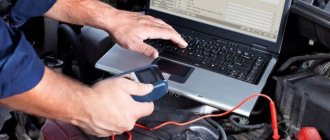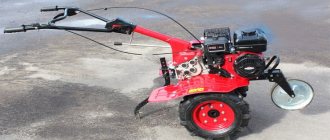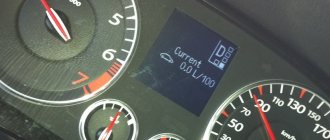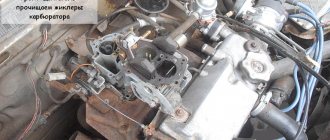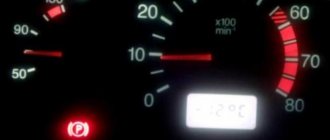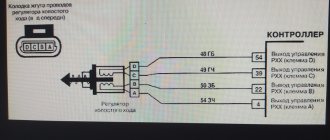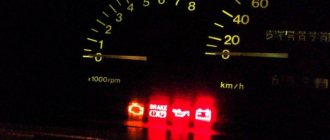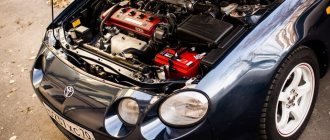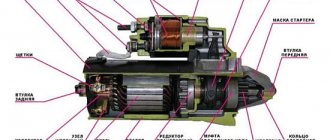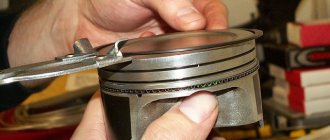Each car consists of many components and consumables that require regular maintenance or replacement. And if you do not carry out routine maintenance, you may encounter various problems in the operation of the vehicle. And one of them is high idle speed (idling speed), which leads to unjustified fuel costs.
general information
The problem of high engine idle speed is very common, and it manifests itself in both injection and carburetor power plants. And there are many reasons that cause such a breakdown, so before starting repairs, it is important to understand what led to it.
It doesn't take a car expert to notice that your car is idling at high speeds. Even a beginner can carry out primitive diagnostics, since the problem will be accompanied by strong engine noise and the appearance of third-party sounds during its operation. You can also analyze the tachometer readings at a specific period of time - if they do not correspond to normal mode, then it’s time to go to the service station.
The normal speed at idle depends on the engine size. The average rate varies in the range of 650−950 rpm. in a minute. If these indicators are displayed on the dashboard, most likely everything is fine with the engine. If there is a slight deviation from the average statistical norm, there is no cause for concern. In many modern cars that are equipped with injection units, as the speed increases, an indicator light comes on, indicating the need for a technical inspection.
If the problem is not corrected, this can lead to various problems . Among them:
- Uneconomical fuel consumption. As the speed increases, a significant part of the fuel-air mixture is wasted.
- Reduced engine service life. The malfunction affects both the life of the motor and the installation itself.
To prevent unnecessary costs and return the car to its previous performance, you need to immediately send it for diagnostics. Service center employees will carefully check the engine for serious damage, find the cause of the increased speed, and then offer the best options for eliminating it.
Also, motorists are faced with a problem in which the speed begins to “float” from high to low and back again. In most cases, this occurs due to classic damage to individual components or their incorrect configuration.
Choosing an auto electrician - main features
Most problems with increased speed, increased fuel consumption, and unstable idling are solved by an electrician. This specialist finds problems in the electrical part of the car, diagnoses all components, and carries out repair work in the electrical part. You are unlikely to figure this out on your own; you will have to try hard to study the wiring diagram for all the parts of your car. And finding the location of all the sensors is often difficult, especially in a technologically complex modern car. So you need to entrust the work to an experienced craftsman.
When choosing an auto electrician, consider the following features:
- official service - in most cases this will be the best solution, since here specialists work only with one specific brand of car and provide a guarantee of quality;
- the equipment of the service station plays an important role in identifying potential problems in your car; you just need to make sure that the station is well equipped and has normal equipment;
- experience of a specialist - pay attention to who exactly will service your car, the technician must be quite experienced, it is better to check reviews about him from different sources;
- a good option is to choose an electrician by recommendation; if you do not use the services of an official station, the recommendations of your friends will help you find the optimal service;
- It is worth starting cooperation with diagnostic services; diagnostics will show how competent the specialist is and whether there is any point in further cooperation with these specialists.
As you can see, there are several ways to check a person’s competence and make sure of his professionalism. If you decide to have your car serviced at an unverified station, be sure to be present during the repair and monitor every step of the technician. This is your right, it is quite possible to be present during repairs even in a garage station, where not a single master will like it. You can leave your car unattended either with the officials or with a trusted service that you have been working with for quite a long time. Keep this in mind the next time you need to go get your car repaired.
Carburetor models
The era of carburetor-type engines has long come to an end, so it is very difficult to find them under the hood of modern cars. However, there are people who are not going to abandon the domestic automobile industry and turn to car services with a complaint that their VAZ-2109 stalls at idle.
Injection engines have long occupied a leading niche, and it would be logical to become familiar with the reasons for high idle speeds in the presence of an injector, but most of them have something in common with carburetor engines. Therefore, first of all, you need to understand why the speed increases on old power plants with carburetors. The following factors can lead to this:
It may also be interesting: “Check” icon on the dashboard of a car: what does it mean?
- Incorrect system adjustment. If the idle speed control unit has been adjusted incorrectly, which often happens after routine carburetor repairs or cleaning, a problem with high speeds is inevitable. Also, when servicing a car independently, many drivers choose the proportions of air and fuel incorrectly, and this is also a serious mistake.
- Damage to the throttle valve. If there is a loss of sealing of this element, the risk of increasing idle speed will be maximum. Often the throttle valve stops working normally due to carbon deposits appearing on it. Therefore, experts advise cleaning the part. And if it was seriously damaged, for example, cracked, then you will have to replace it. Such an event can only be implemented on some carburetor engines.
- Needle valve position. With this problem, the fuel chamber will receive incorrect portions of the fuel-air mixture.
- Burnt out cylinder block gasket. The problem can be resolved by simply replacing the gasket. To make sure that a part has been damaged, it is enough to check its condition while the engine is running. If white smoke starts coming out after opening the hood, it means the gasket needs to be changed.
- Open suction. The malfunction is diagnosed by checking the quality of operation of the damper in the primary chamber. If failures were detected at the inspection stage, all that remains is to look at the operation of the choke. In most cases, the problem is solved simply - the motorist needs to lubricate the damper drive and cable.
When the engine starts, the rpm rises to 2000
#1 Evgeny Evgenievich
People, it happened out of the blue. The idle speed has become 2000 and does not drop. Sometimes, while driving, when turning on neutral, the revolutions jump from 0 to 3000, and the needle jumps quickly: a sharp jump and again to 0. After a few seconds, again 2000
I changed three sensors: throttle sensor, idle speed sensor, air sensor (well, the one after the air filter)
Did not help. Tell me what to do next?
#2 kriaki
People, it happened out of the blue. The idle speed has become 2000 and does not drop. Sometimes, while driving, when turning on neutral, the revolutions jump from 0 to 3000, and the needle jumps quickly: a sharp jump and again to 0. After a few seconds, again 2000
I changed three sensors: throttle sensor, idle speed sensor, air sensor (well, the one after the air filter)
Did not help. Tell me what to do next?
#3 Evgeniy Evgenievich
Comrade Hot had such problems a year ago, they cured it with a dose of antifreeze, although now she has started having such problems again, try to pull the throttle, maybe there is already exhaustion and the damper itself is dangling, and it happens that the rubber hoop from the throttle cable flies off and the drive gets under the cable flaps. I hope it helped
#4 andreypurshev
#5 Evgeny Evgenievich
When the pedal is released, the throttle cable on the injector should have some slack - is it stretched by accident?
no, everything is fine with the cable
and then, what does the sagging of the cable have to do with it when there is a limiter there. so the damper itself is at zero position (i.e. not open at all)
#6 kriaki
When the pedal is released, the throttle cable on the injector should have some slack - is it stretched by accident?
#7 Evgeny Evgenievich
#8 Sergey
View Garage
#9 Evgeny Evgenievich
In short, look, if the IAC and TPS are 100% working, although I doubt the latter, then you still need to clean the fuel pump mesh.
PXX bitch was defective. Thanks everyone, everything works.
I wasted 2000 rubles on an air sensor!
#10 Sergey
View Garage
PXX bitch was defective. Thanks everyone, everything works.
I wasted 2000 rubles on an air sensor!
#11 mrstorm
PXX bitch was defective. Thanks everyone, everything works.
I wasted 2000 rubles on an air sensor!
#12 Sergey
View Garage
where was the marriage discovered? I have exactly the same problem. In the next topic they said that the TPS is acting up.
#13 Chronos
View Garage
In the Russian ХХ itself. It just doesn't work correctly.
#14 mrstorm
#15 KVakin
#16 Sergey
View Garage
Can you tell me where exactly this IAC sensor is located? Can I change it myself?
On the throttle assembly. Unscrew the two screws, clean everything in the holes, lubricate the IAC sealing ring with oil and install it, and that’s it.
Hello everyone! I have almost the same problem - I say “almost” because I have a problem that appears and disappears. It disappears when moving above 3rd gear and appears when standing in traffic jams for literally 10 minutes (the revs jump from 800 to 2000-2500 at idle.). What could be going on here? Do you need to adjust the throttle valve drive or is some sensor still missing? What are your thoughts?
#17 ethereal
Hello everyone! I have almost the same problem - I say “almost” because I have a problem that appears and disappears. It disappears when moving above 3rd gear and appears when standing in traffic jams for literally 10 minutes (the revs jump from 800 to 2000-2500 at idle.). What could be going on here? Do you need to adjust the throttle valve drive or is some sensor still missing? What are your thoughts?
#18 Seny_g
Theme Options
Search by topic
Injection engines
The listed reasons for increased idle speed apply to carburetor engines. But many of them make themselves felt on injectors. However, in the second case, problems with electronics are added to the list of problems. High idle speed on injection engines is explained as follows:
- Incorrect setting or damage to the antifreeze temperature control sensor. If the unit fails, the engine will succumb to constant warming up, which will not allow it to freely drop speed. This is due to the fact that the control unit does not receive any information (or receives it, but incorrectly) about the current degree of heating of the power plant, so it will try to heat it. In addition to uneconomical fuel consumption and high idle speeds, the problem can cause a more serious problem - overheating of the engine with subsequent failure. In this case, you will have to carry out complex and expensive repairs to the unit. To determine problems, just use a diagnostic scanner.
- Damage or malfunction of the throttle position sensor. This element is one of the most important in all injection engines. If it supplies the ECU with incorrect data indicating that the throttle is opening, the speed will constantly increase. The problem is caused by jamming or complete damage to the part.
- Damage to the return spring or problems with its operation. As the vehicle is used, the return spring may stretch or jump out of place, which will lead to the problem in question. You can restore the previous state through your own efforts.
- Throttle cable sticking. The defect appears in older car models, for example, VAZ 2107, 2109, 2110, etc., and is solved by simply replacing the cable or applying lubricant to the existing part.
- Damage to the sealing gaskets on the injectors. It is very difficult to determine such a breakdown, and during maintenance it is carried out last. If the gaskets are damaged, additional air enters the combustion chambers, which increases the speed.
It may also be interesting: What material to choose from for car mats
Topic: High speed (up to 2,200 rpm) when starting the engine. What is the reason?
Theme Options
Search by topic
Good afternoon, colleagues. A question. Recently (a month or two), when starting the engine when it is cold (after parking overnight), the engine immediately spins itself up to 2,200 rpm at
.
At the same time, such high revolutions last for about 10-15
seconds, then the revolutions drop to 1600, then after another 20 seconds the revolutions drop to 1200 and after another 20 seconds to 800 revolutions. Previously, when starting from cold, the engine speed increased to 1600 (I don’t know if this is the norm?), then dropped to 800 within a minute or a minute and a half.
Why are the revs so high at the start? After all, this harms the engine.
When starting the car, I naturally do not press the gas pedal. I always fill up with AI95 at proven gas stations. VAG COM
I didn't find any errors on the engine.
There are not many options, check the damper and air leaks.
Sent from my GT-I9082 via Tapatalk
WinterSunSet
, Try to test the intake tract, there is a suspicion that there is an air leak.
fibonathi
,
Poltos
, What is the relationship between air leaks and high speeds? On the contrary, I thought that the speed would float when there was suction. Please explain to broaden your horizons.
When cold there is a weak one, after heating and expansion of the parts it disappeared.
Sent from my GT-I9082 via Tapatalk
Electronics problems
Unlike carburetor engine models, injection engines are completely dependent on electronic devices, and most importantly, on the electronic control unit, which distributes and configures the functions of all components depending on the current operating conditions. And if the ECU stops receiving accurate information about air volume due to the problems listed above, this is accompanied by more serious failures .
First of all, the controller will cause an increase in speed in order to enrich the fuel with air, and the ready-made mixture will be sent directly to the engine, but in the wrong proportion. As a result, the power plant will begin to malfunction or stall altogether, and all due to the incorrect composition of the fuel-air mixture.
As the speed decreases, the volumes of sucked air masses decrease. But after some time, the proportions of fuel and air will be restored, respectively, and the speed will become normal, but not for long. Soon they will begin to fall or “float”, which indicates the presence of failures in the internal combustion engine, TPS or mass air flow sensor. In addition, you need to take into account the possibility of air leaks at the intake valve.
Let's sum it up
There can be a lot of problems with unstable engine speed. Almost every sensor can produce a similar effect. It is also interesting that the motor can give increased speed due to conflicts in the firmware, troubles with contacts in the electrical wiring. Problems can even arise simply due to bad fuel or clogged filters. It’s worth starting repairs with diagnostics. If you have not changed the filters or carried out regular maintenance for more than 1 year, it is worth doing this process. Don't forget that a car engine depends on the quality of the lubricant; bad oil can simply be detrimental to engine hardware parts.
Restoring a car that exhibits high idle speed begins with checking the operation of the electrical equipment. It is the sensors and wiring that most often lead to the fact that the motor operates unstably and does not provide the desired characteristics. But problems can also be hidden in spark plugs, ignition coils, high-voltage wires and other elements. Sometimes the problem is due to the timing belt jumping under heavy loads. In such situations, the operation of the engine will initially be unstable and become a problem for your car. Comprehensive service and high-quality diagnostics will help solve problems. Have you ever encountered high speeds after starting the engine?
Source
Idle speed control
The reason for the increase in speed at idle may be a damaged or incorrectly configured servo device - a special regulator installed in the air duct. Its task is to force a change in the speed value to ensure a smooth transition of the power plant to idle mode after removing the foot from the gas pedal. Simply put, the engine does not immediately begin to slow down, but does so slowly and evenly.
The servo device is also responsible for increasing the speed when starting the car, and then decreasing it after entering the working gear. An increase in values also occurs when the load on the engine unit increases at idle, for example, when the air conditioner is turned on, the seats or mirrors are heated, the headlights and dimensions are turned on. Damage to the unit is accompanied by an increase or floating of revolutions.
It will also be interesting: Instructions for washing injectors and injectors with your own hands
Clogged injectors
If the injectors are dirty or clogged, this will certainly increase the engine speed. The main cause of the malfunction is the use of low-quality fuel. And if this is really the problem, then it’s worth cleaning the injectors.
These are perhaps the most common reasons that can cause an increase in engine speed when idling. You can find out about others in this article. I hope this information will help solve the problem with the idle speed of your car.
Source
Air valve
If there is a problem with excess air being sucked in, it is important to check the special air valve for damage. We are talking about a device that increases the speed when starting and warming up an internal combustion engine. To shut off the air supply, the unit is equipped with a special damper or rod with a sensitive thermoelement, which works like a thermostat and automatically determines the appropriate conditions for the start of suction.
When the engine is warm, the choke extends fully to stop the flow. Next, the electronic control unit calculates the optimal air volumes and reduces fuel consumption. This is also accompanied by a decrease in speed.
But if the engine is not warmed up, the unit is fully open and begins the process of enriching the fuel mixture with air. Problems with speed appear both as a result of damage to the device itself and due to incorrect operation of the temperature sensor.
Engine operation at warm-up speeds
In general, high revs on a cold engine in cold weather is normal. However, their meaning and the duration of operation of the motor in this mode may vary. So, if you start the engine at a temperature, for example, from +20°C and above, then the time when the idle speed value returns to that specified in the manual (approximately 600...800 rpm) will be several seconds (2...5 seconds in summer time and about 5...10 seconds in winter). If this does not happen, then there is a breakdown, and additional inspection and appropriate repair measures must be performed.
As for starting a gasoline engine cold at a temperature of, for example, -10°C, high warm-up speeds will be approximately twice the idle speed indicated by the manufacturer. Accordingly, the lower the temperature, the longer the time to return to normal idle speed will be.
High speeds when starting the engine when cold are necessary for two reasons. The first is a gradual warming up of the engine oil, and accordingly, a decrease in its viscosity. The second is gradual heating of the engine to the normal operating temperature of the coolant, which is about +80°C...+90°C. This is achieved by increasing the amount of fuel burned.
Therefore, the appearance of high speeds when starting the engine when cold is normal. However, it is necessary to take into account their value and the time after which they return to the value corresponding to idle speed. The speed and time values are indicated in the technical documentation for a specific vehicle. If the speed and/or return time are increased, then it is necessary to look for the cause of the breakdown.
